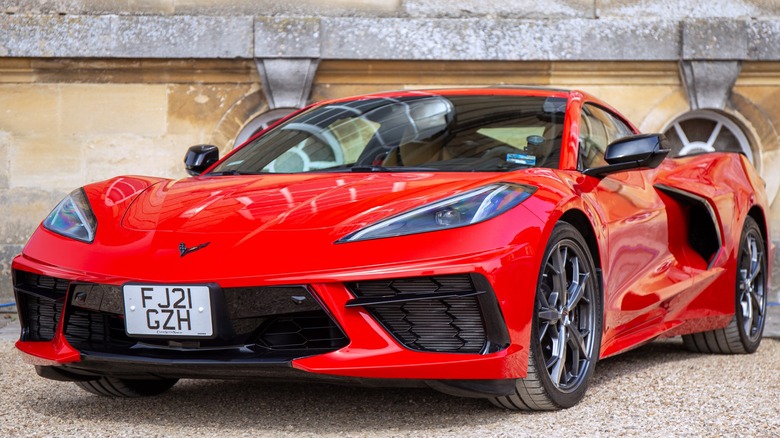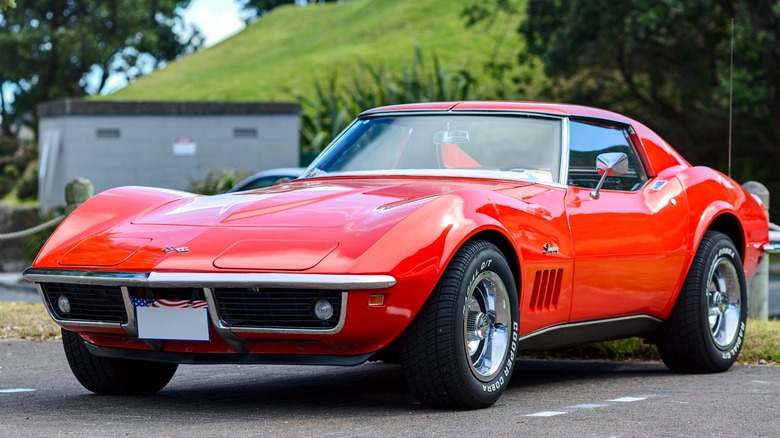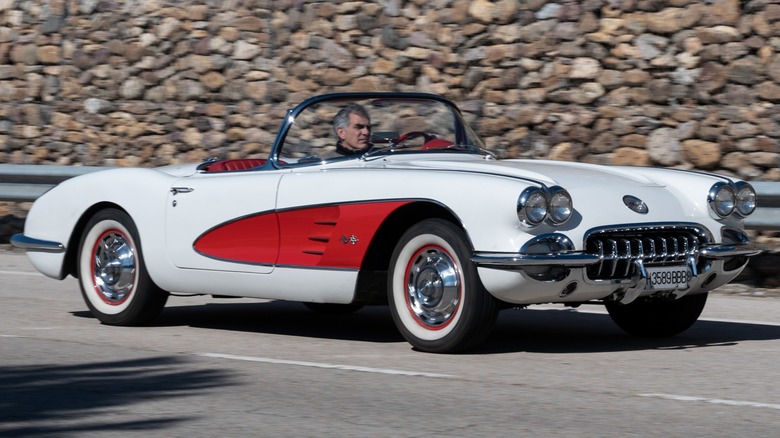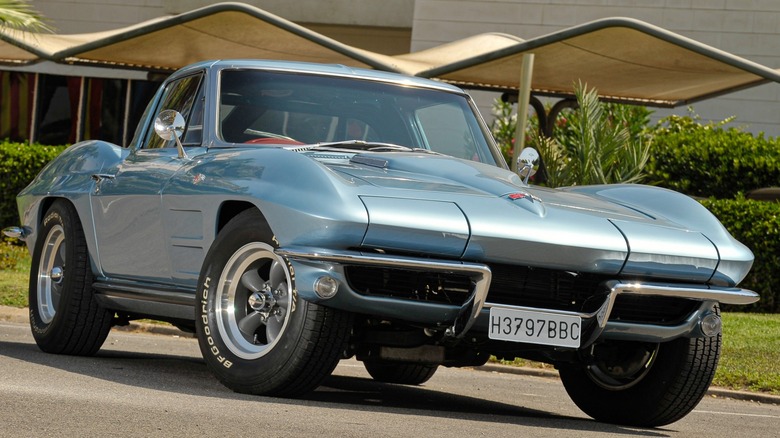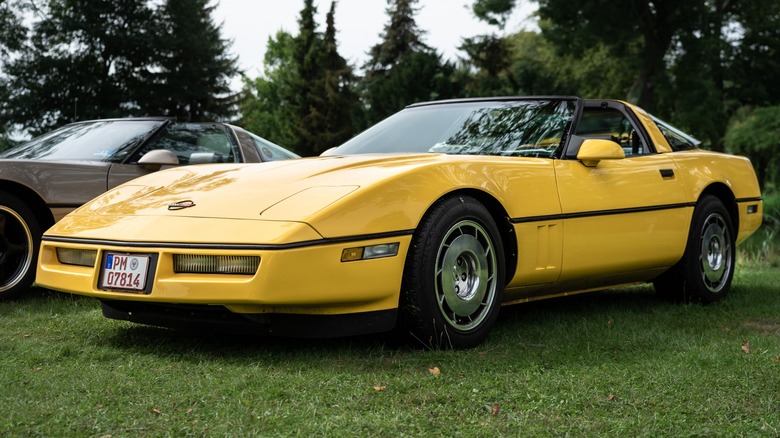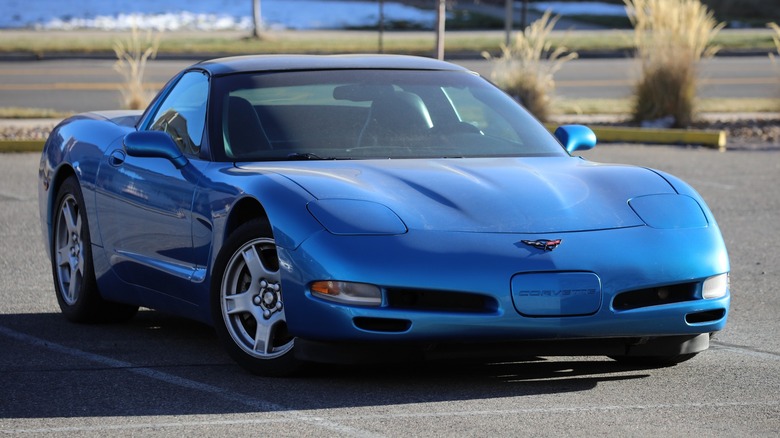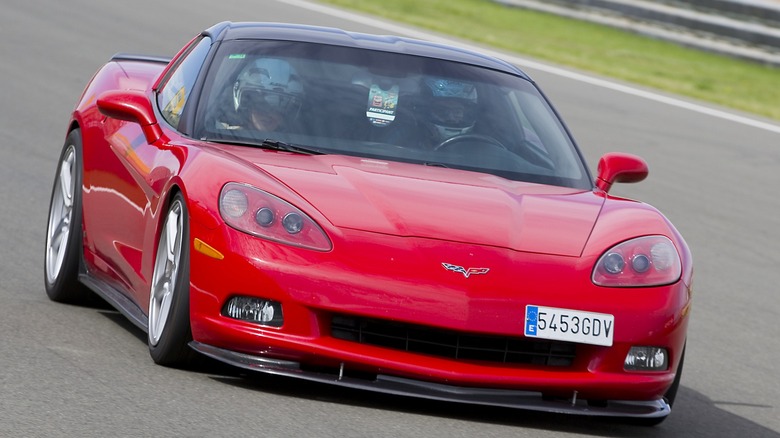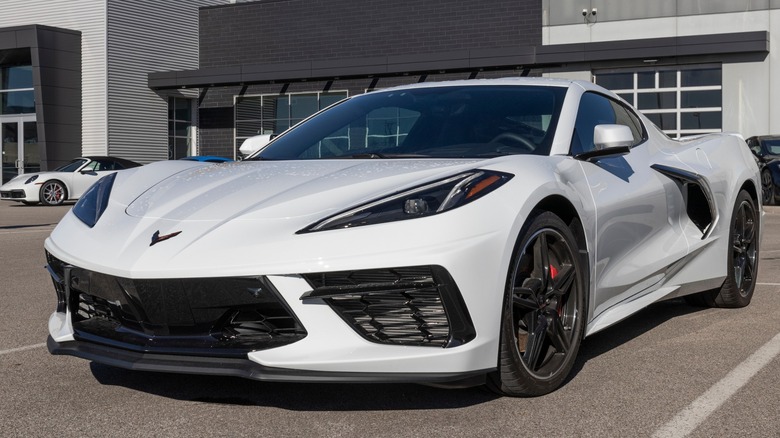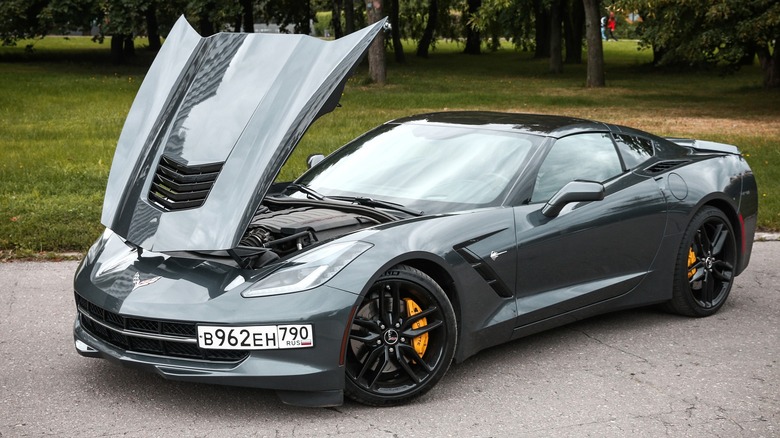Every Generation Chevy Corvette Ranked Worst To Best
For over 70 years and eight generations, Chevrolet has produced America's best sports car. It began in 1953 with the introduction of a two-seat roadster built with fiberglass body panels and equipped with Chevrolet's reliable Blue Flame inline-six designed to compete with British sports cars. All the production cars were painted Polo White and boasted a red interior. Chevrolet produced 300 Corvettes in 1953 and sold only 183 of them. However, by the end of the C1 generation, sales had improved significantly. In 1962, Chevrolet sold 14,531 Corvettes.
Throughout the following generations, Chevrolet produced some of the best sports cars in the world. But, like all other automakers, a few models, while still remarkable cars, fell short of the Corvette standard of excellence. Over the years, the Corvette evolved from the sports car classification to the "supercar" category. The introduction of the C8 mid-engine model offered a Corvette with a European design that competed with Ferrari, Lamborghini, and Porsche, but at a much lower price point.
Chevrolet celebrated the legendary sports car's 70th birthday in 2023 with the arrival of the C8 generation Corvette Z06 equipped with a 5.5-liter V-8 cranking out 670 horsepower and 460 lb-ft of torque. Here is every generation Chevy Corvette ranked from worst, albeit most of the "worst" Corvettes still outperformed many of its competitors, to best.
8. C3 Corvette: 1968-1982
The C3 Corvette trails the list of Corvette generations for the drastic decline in power output and performance caused by the malaise era from 1973 to 1983. While the Environmental Protection Agency (EPA), created in 1970, and the Clean Air Act implemented measures successfully improved the environment and protected human health, the mandates severely impacted the auto industry. Directives to reduce pollution, improve automobile fuel efficiency, and augment safety standards resulted in a significant drop in performance and ultimately killed the 1960s-style American muscle car.
Although the base model 1975 "ZQ3" Corvette displayed the sleek and sporty lines characteristic of America's stylish sports car (though fitted with federally mandated five mph crash bumpers), the output was reduced to a paltry 165 horsepower. It was equipped with a 350-cubic-inch V8 producing half the compression of previous models and a power-sucking catalytic converter.
However, some models carried on the high-performance tradition. The 1970 LT-1 Corvette fitted with a small block, 350-cubic-inch, V8 engine generated 370 horsepower. Chevrolet continued the 1978 fastback Corvette design for the 1979 models along with some minor interior changes and offered the base L48 and optional L82 engine, both 350 CID small-block V8s. The L82-equipped Vettes produced 225 horsepower, achieved with larger valves, a high-performance cam, an augmented compression ratio, and a more efficient exhaust system. Road and Track test results showed the 1979 Corvette L82 accelerating to 60 mph in 6.6 seconds and reaching the quarter mile in 15.3 seconds at 95 mph.
7. C1 Corvette: 1953-1962
Although the first C1 Corvette, introduced in 1953, deserves recognition as the model with jaw-dropping good looks that started an uninterrupted seven decades of American automotive engineering innovation, its performance was subpar. The underpowered 235-cubic-inch inline six-cylinder engine and mediocre two-speed automatic transmission were enough to deter potential sportscar-hungry customers.
Over the following nine years, the C1 Corvette evolved into a sports car with performance features to compete with some European models. Chevrolet upgraded the 1955 Corvette engine to a 265-cubic-inch V-8 and mated it to a three-speed manual transmission. In 1956, the body changes included a revised front end and scalloped sides, while the V8 carried over from the previous year produced 210 horsepower with a revised cam and Carter four-barrel carburetor. In 1957, the automaker augmented the V8 displacement to 283 cubic inches and added fuel injection to produce 283 horsepower.
By 1962, Chevrolet had made significant upgrades to the Corvette that boosted sales, and most Corvette enthusiasts would agree it was the best model year of its generation. Chevrolet replaced the 283 cubic-inch engine with the 327 cubic-inch V8 producing more horsepower and torque than any previous Corvette powerplant. The Corvette 2-door hardtop coupe 327 V8 mated to a 4-speed manual transmission generated 340 horsepower at 6,000 rpm and 344 ft-lb of torque at 4,000 rpm. The sportscar accelerated from 0-60 mph in 5.7 seconds and reached the quarter mile in 14.4 seconds on its way to a top speed of 139 mph.
6. C2 Corvette: 1963-1967
In 1963, Chevrolet introduced perhaps the most recognizable of all Corvettes, the iconic Sting Ray. The automaker produced the "Split Window" Coupé for only one year, but the sleek and sculpted fiberglass body design with an aggressive stance, hidden headlights, unique side vents, and independent rear suspension was an instant sensation. Equipped with the 327 cubic inch V8 producing 340 horsepower and a three-speed manual gearbox, the Sting Ray Sport Coupe accelerated to 60 mph in 5.6 seconds and reached the quarter mile in 14.2 seconds.
Chevrolet built another standout Corvette during the C2 generation. Considered by many to be one of the best Corvettes of all time, the L88 was offered as an option package in 1967. It featured a tuned big block Chevy 427-cubic-inch V8 engine with a manufacturer-rated output of 430 bhp at 5400 rpm. However, actual output was likely between 540 and 580 horsepower. A heavy-duty M22 four-speed manual transmission sent power to the rear wheels.
For maximum performance, weight reduction was achieved by removing the power steering, air conditioning, and the car radio. The L88 was also equipped with a performance suspension package, a Positraction rear differential, a transistor ignition, and upgraded brakes with heavy-duty disc brake calipers. Discouraged by the exclusive use of racing-grade gasoline and the hefty $1,500 option price added to the base price of $4,240.75, few buyers selected the L88 option. Only 20 were produced for 1967, and racing teams purchased most of the early models.
5. C4 Corvette: 1984-1996
The disappointing arrival of the C4 Corvette in 1984 can be attributed to several factors. The sports car lacked a distinctive body style typical of former corvettes with flowing lines and aerodynamic shapes. The introduction of the Cross-Fire Fuel Injection technology that promised performance improvements quickly became a reliability nightmare. And owners complained that the poor ride characteristics made the driving experience less enjoyable than expected.
However, the C4 generation began a period in the history of the Corvette that witnessed a steady increase in horsepower every year. Although several later C4 Corvette models made significant contributions to the sports car's enduring style and superior engineering, the 1996 Corvette Grand Sport and the ZR-1 Corvette represented the best of the C4 generation. The special edition Grand Sport was distinctive for its unique Admiral Blue exterior featuring Arctic White stripes paying tribute to the classic Corvette Grand Sport Racer of the 1960s. The interior featuring a headrest embroidered with a specialized Grand Sport emblem. Chevrolet produced only 1,000 Grand Sports (810 coupes and 190 convertibles) all equipped with a revised LT4 5.7-liter small-block V8 producing 330 horsepower.
In 1990, Chevrolet reintroduced the ZR-1 with a state-of-the-art engine designed by Lotus. The all-aluminum DOHC 5.7-liter V-8 LT5 generated 375 horsepower and 370 lb-ft of torque. The ZR-1 accelerated to 60 mph in a mere 4.5 seconds and reached a top speed of 180 mph, impressive numbers for 1990. Chevrolet made only 7,000 ZR-1 cars from 1990 and 1995.
4. C5 Corvette: 1997-2004
The C5 Corvette was a new design based on market research with input the automaker solicited from past and present Corvette owners. The survey responders requested a Corvette with a distinctive look, different from that of a Ferrari or NSX, and they specified quality construction, performance, and safety as their top desires. Chevrolet made the C5 with 1,500 fewer parts than the C4, of which only a few had been used in previous models.
For the C5 generation, Chevrolet continued the power output growth trend of the C4 generation. The introduction of the LS1 V8 engine set high standards, producing 345 horsepower in a powerplant that proved to be reliable even when pushed to the limits of performance.
Perhaps the Corvette Z06, a variant of the Fixed Roof Coupe (FRC), introduced in 2001, represents the most notable special edition of the C5 generation. It was equipped with an LS6 engine that produced 385 horsepower and 385 lb-ft of torque in 2001 and 405 horsepower at 3500 rpm and 400 lb-ft at 4800 rpm in later years. The increase in power over the 2001 model can be partially attributed to a high-performance camshaft that increased the intake-valve lift by 0.7 mm to 14mm and exhaust lift by 0.5mm to 13.9mm. A six-speed manual transmission sent power to wide wheels and tires. Superior power and weight savings with thin glass, reduced sound-deadening materials, and the FE4 magnetic ride suspension systems help the Z06 achieve exceptional performance.
3. C6 Corvette: 2005-2013
The C6 models were lighter, faster, and more sophisticated than those of the previous generation. The return of the convertible option alongside the coupe with the 2013 Corvette 427 took performance to a new level. The 2013 Corvette 427 convertible Collection edition with components from the Z06 and the ZR1 exhibited performance well beyond previous 427 models making it the fastest roadster in Corvette's history.
Chevrolet fitted the convertible with the LS7 engine that generated 505 horsepower and 470 lb-ft of torque, connected it to a six-speed manual transmission. The mill was made with titanium connecting rods and equipped with a dry-sump oiling system that kept the engine well-lubricated even during spirited driving conditions.
Designed with an emphasis on reduced weight, the Corvette 427 Convertible weighed a mere 3,355 pounds (1,522 kg). Chevrolet built the frame with lightweight aluminum and used carbon fiber to form the front fenders instead of the traditional Corvette fiberglass. The result was a power-to-weight ratio of 6.64 (one horsepower for every 6.64 pounds of vehicle mass), a better ratio than that found on some supercars such as the Ferrari California.
2. C8 Corvette: 2020-Current
Chevrolet placed the Corvette in the supercar category with the introduction of the C8. The exotic style, mid-engine layout, and performance rivals many supercars, without the exorbitant price. The 2023 Corvette is available in three trim levels: 1LT, 2LT, and 3LT. All are offered as a coupe or a convertible with a power-retractable hardtop. The coupe's roof lifts off with a detachable upper panel for open-air motoring.
Chevrolet also offers the Z51 Performance package on the C8 models, designed to prevent overheating or loss of braking efficiency at high speeds on the track and improve handling with robust suspension components and aerodynamic features that increase downforce. Power is supplied to the rear wheels on all the basic trims with the mid-mounted 6.2-liter V8 engine mated to an eight-speed dual-clutch automatic transmission. The engine produces 490 or 495 horsepower (depending on the trim) and 470 lb-ft of torque.
The star of the C8 generation is the 2023 Corvette Z06 with features and performance that blur the lines between a race car and a road car. The 5.5-liter LT6 naturally aspirated engine generating a whopping 670 horsepower at a peak of 8,600 rpm is the most powerful engine of its kind (no superchargers) on any production car. The Z06 is one of the fastest ICE cars on the market, hitting 60 mph in 2.6 seconds with a top speed of 189 mph. The Corvette Stingray Z51 is a close second, reaching 60 mph in 2.8 seconds and 184 mph.
1. C7 Corvette: 2014-2019
Although the C8 Corvette is the most advanced Corvette ever made, the C7 makes the top of the list of best Corvettes for its performance as the last of the traditional front-engine models. Chevrolet decided to send off the conventional model with a bang, creating the most powerful and fastest Corvette in the history of the brand to date: the 2019 C7 ZR1.
The 2019 Chevrolet Corvette Stingray puts up some impressive performance numbers, built with its poster-worthy exterior design, a chassis providing a comfortable ride, exceptional handling abilities, and a 455 horsepower V8. However, the ZR1 is even better. An LT5 6.2L V-8 supercharged engine powers the Corvette ZR1 producing a mindboggling SAE-certified 755 horsepower and 715 lb-ft of torque. Chevrolet offered the ZR1 with either a seven-speed manual or an optional eight-speed automatic transmission. To reduce weight, the ZR1 is made with numerous carbon fiber components including a unique carbon-fiber hood with a central opening required to house the supercharger/intercooler assembly.
Tests show the ZR1 accelerating to 60 mph in just 2.85 seconds and reaching 100 mph in six seconds flat. The ZR1 is not only quick but demonstrates endurance and durability under stressful driving conditions. The supercar drove for a continuous 24 hours at Virginia International Raceway, with stops only for fuel and to change tires, setting a new lap record with a time of 1.37 seconds faster than the Ford GT.
